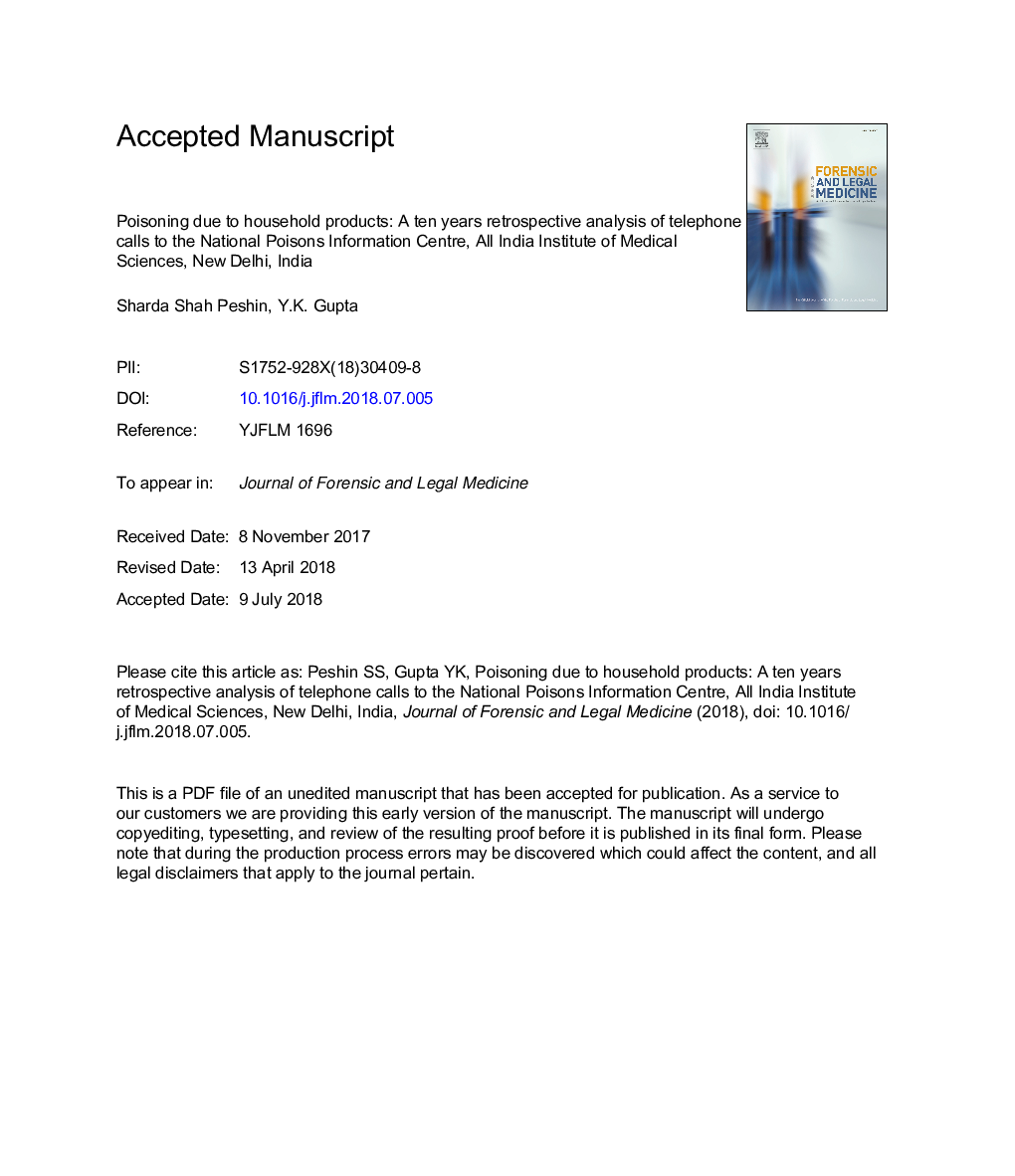| کد مقاله | کد نشریه | سال انتشار | مقاله انگلیسی | نسخه تمام متن |
|---|---|---|---|---|
| 6554932 | 1422412 | 2018 | 30 صفحه PDF | دانلود رایگان |
عنوان انگلیسی مقاله ISI
Poisoning due to household products: A ten years retrospective analysis of telephone calls to the National Poisons Information Centre, All India Institute of Medical Sciences, New Delhi, India
ترجمه فارسی عنوان
مسمومیت با توجه به محصولات خانوار: تجزیه و تحلیل گذشته نگر از تماس تلفنی به مرکز اطلاعات سم شناسی ملی، موسسه علوم پزشکی همه هند، دهلی نو، هند
دانلود مقاله + سفارش ترجمه
دانلود مقاله ISI انگلیسی
رایگان برای ایرانیان
کلمات کلیدی
مسمومیت محصولات خانگی، مسمومیت تصادفی فرزندان، آفت کش ها، پریتروئید، پاک کننده های خانگی، جلوگیری،
موضوعات مرتبط
علوم زیستی و بیوفناوری
بیوشیمی، ژنتیک و زیست شناسی مولکولی
ژنتیک
چکیده انگلیسی
Extensive use of different chemicals in various fields and their easy availability has led to an increased incidence of accidental and intentional poisoning in developing countries including India. A diverse range of household products commonly used for domestic purposes comprise pesticides, household cleaners, thermometer mercury, antiseptics, kerosene, paint thinners etc. Any of these products, if misused or mishandled can cause poisoning. In India, the National Poisons Centre (NPIC) at the All India Institute of Medical Sciences, New Delhi, provides information on management of poisoning to treating physicians. Analysis of data based on telephone calls received by the NPIC (April 2006-March 2016) has highlighted a high incidence of poisoning due to household products, followed by pharmaceuticals, agricultural pesticides and industrial chemicals. The objective of the present retrospective study was to determine the incidence of poisoning due to various household products as reported to the NPIC during the ten years period. The total number of calls received by the Centre was 16,420. There were 7114 calls (45.5%) due to household products with adults (>18yrs.) and children (<1-18yrs.) constituting 38.7% and 61.2% calls respectively. Males outnumbered females (Mâ¯=â¯62.4%, Fâ¯=â¯37.5%). The mode of poisoning was mainly unintentional (66.8%) followed by intentional mode (33.2%). The commonest route of exposure was oral (95.6%). Household pesticides were commonly implicated (43.7%) followed by household cleaners (21.8%), thermometer mercury (5.2%) naphthalene balls (5%), antiseptics (3%), kerosene (2%) and paint thinner (2%). Miscellaneous products comprising of camphor, silica gel, hair dye, nail polish remover, cosmetics, adhesives etc were also involved in poisoning (17.1%). The trend and pattern of poisoning varies in different parts of the country, because all calls on poisoning are not reported to the Centre. So the data as such may not be a true reflection of the scenario in India. However, the results do indicate an increasing incidence of poisoning due to household products especially in children. The probable reasons for high incidence could be careless storage, ignorance, non compliance with prescribed instructions for use and negligible parental supervision in case of children. The results of the study highlight, an urgent need to identify high risk circumstances, common toxic products involved and implementation of prevention and awareness programmes, to achieve poisons control at home.
ناشر
Database: Elsevier - ScienceDirect (ساینس دایرکت)
Journal: Journal of Forensic and Legal Medicine - Volume 58, August 2018, Pages 205-211
Journal: Journal of Forensic and Legal Medicine - Volume 58, August 2018, Pages 205-211
نویسندگان
Sharda Shah Peshin, Y.K. Gupta,
